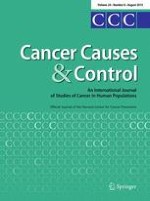Published in:

01-08-2013 | Original paper
Associations among family history of cancer, cancer screening and lifestyle behaviors: a population-based study
Authors:
Georgiana Bostean, Catherine M. Crespi, William J. McCarthy
Published in:
Cancer Causes & Control
|
Issue 8/2013
Login to get access
Abstract
Purpose
Some cancers are largely preventable through modification of certain behavioral risk factors and preventive screening, even among those with a family history of cancer. This study examined the associations between (1) family cancer history and cancer screening, (2) family history and cancer preventive lifestyle behaviors, and (3) cancer screening and lifestyle behaviors.
Methods
Data were from the 2009 California Health Interview Survey (n = 12,603). Outcomes included screening for breast cancer (BC) and colorectal cancer (CRC) and six cancer preventive lifestyle behaviors, based on World Cancer Research Fund recommendations. Multivariate logistic regression analyses, stratified by gender and race–ethnicity, examined associations. Predicted probabilities of cancer screening by family cancer history, race–ethnicity, and sex were computed.
Results
Family history of site-specific cancer—CRC for men and women, and BC for women—was associated with higher probability of cancer screening for most groups, especially for CRC, but was largely unrelated to other lifestyle behaviors. In the few cases in which family history was significantly associated with lifestyle—for example, physical activity among White and Latino males, smoking among White and Asian females—individuals with a family history had lower odds of adherence to recommendations than those with no family history. Greater overall adherence to lifestyle recommendations was associated with higher odds of up-to-date CRC screening among White and Asian males, and lower odds among Asian females (no significant association with BC screening); this relationship did not vary by family cancer history.
Conclusion
The fact that family history of cancer is not associated with better lifestyle behaviors may reflect shared behavioral risks within families, or the lack of knowledge about how certain lifestyle behaviors impact personal cancer risk. Findings can inform interventions aimed at lifestyle behavioral modification for individuals at increased cancer risk due to family history.